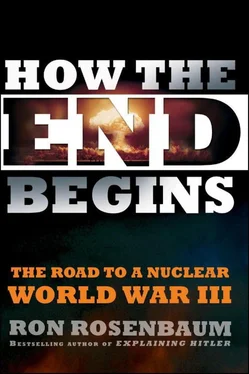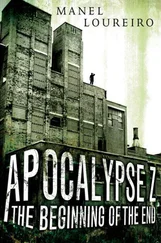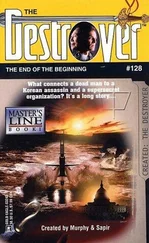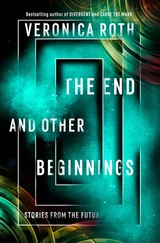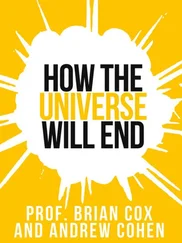The Burke documents, I’ve come to believe, are not just a historical footnote to nuclear strategy history but could serve as evidence of the still urgent need for debate over whether a civilization-destroying nuclear war, a world holocaust, is avoidable or inevitable. Electronic Briefing Book #275—the digital collection of the Burke documents, whose publication coincided with my visit—seemed to me a sensational recovery of a lost past, a lost path in nuclear history.
In Burke, I came across a plan. Not for Zero, which I still believe is probably unattainable. But for ten. Or less than a hundred. One that sacrifices the perfection of Zero for the attainability of minimum numbers.
At the very least the Burke papers offer a contribution to the debate—something I refrained from offering the first time I immersed myself in the mechanics and the morals of nuclear war at the height of the Cold War in part because I couldn’t imagine the experts would have failed to find a fail-safe solution, but they did fail. They were only saved by the bell, by the fall of the Wall from the Armageddon we were heading for.
As it turns out, the late Admiral Arleigh Burke—the unexpected theoretician—first called the worst-case scenario a “world holocaust” more than half a century ago at a decisive turning point in nuclear arms deployment. According to Jesse Sheidlower, the American editor of the Oxford English Dictionary, the word “holocaust” as in “nuclear holocaust” had first been used in 1954. [320]
“Nuclear holocaust” took a while to catch on; it’s a powerful phrase conflating as it does Hitler and Hirsohima, Hitlerizing the nuclear cataclysm. But “world holocaust” seems to have been Burke’s own coinage.
The context was a classified memorandum dated March 4, 1959, I found in the Nuclear Vault’s briefing book on the Burke documents, a memorandum that laid out a blueprint for an alternative to what would be the balance of terror, the Mutually Assured Destruction deterrence based on each side having thousands of highly vulnerable land-based warheads on a hair-trigger alert that would characterize the remaining three decades of the Cold War.
Burke argued for the advantages of submarine-based “finite deterrence.” You needed far fewer submarine-based missiles because submarines would run silent and were thus virtually undetectable, making their deterrent far more reliably survivable than the Air Force’s silo-based missiles. He said stationing our main nuclear force on the American continental landmass automatically made the U.S. and its population the chief target of Soviet nuclear missiles. He said relying on the submarine-launched nuclear missiles just then coming into production under the name Polaris could remove the U.S. landmass as an inevitable first strike target and virtually make a first strike incapable of degrading our retaliatory deterrent capacity.
It was an argument he ultimately lost to the Air Force missleheads. But it could have gone the other way. It would not have been impossible. It was 1959, the U.S. had not yet committed itself to the entire land-based, silo-buried force that would come to be the centerpiece of our nuclear arsenal at its peak.
Who was this Burke fellow and why should his fifty-year-old conception of nuclear war posture matter to us now?
Burke was not known as a nuclear strategist or a defense intellectual. He got to his post of chief of naval operations, highest-ranking naval officer and navy representative on the Joint Chiefs of Staff because of his distinguished World War II record as destroyer captain and because his blunt temperament appealed to both Presidents Harry Truman and Dwight Eisenhower, the latter of whom promoted him over hundreds of other higher-ranking officers to the top Navy job. And he was not a battle-shy type: he’d earned his Navy nickname “31 Knots Burke” because of his aggressive conduct during a Pacific sea battle. [321]
Destroyer boilers were built to pressurize steam so that it powered a top speed of 36 knots. Putting on more speed, and thus pressure, was known to blow out the boilers. Apparently this happened with Burke in the midst of a Pacific battle, when his tin can was charging a Japanese battleship. The boiler blew out, was patched up, but the bandaged version slowed his ship. Still Burke wanted to get in on the action. He thundered down the radio line to the rest of the fleet, “This is Commander Burke coming through at 31 knots.”
Maybe you had to be there.
Burke was there for the birth of the so-called triad, the three-sided nuclear force—missiles, manned bombers, and submarines—the U.S. was embarked upon building. He had a remarkably clear-sighted view of the drawbacks of the land-based elements of the architecture—one that transcended Navy parochialism.
The Burke documents date from internal Navy and interservice memoranda arguing the merits of each leg of the triad. The documents from Burke’s side are notable for their terse but devastating dismissal of assumptions and estimates of the other sides of the triad.
He was confident that—if the Pentagon and the Joint Chiefs could only see the advantages of making submarine-based deterrence the centerpiece of our nuclear arsenal—we could not only save billions of dollars but billions of lives. The alternative—the first strike capability of land-based missiles “hidden” in plain-sight silos—would incite an arms race by each side to destroy the other’s first strike capacity first and increase the chance of nuclear war and world holocaust. Instead, Burke argued, invulnerable submarine-based retaliatory deterrence was the best way to a peaceful stalemate. Let there be competition in the economic and political spheres. Just rule out striving for a first strike capacity by allowing (through negotiation) each side just enough sub-based nuclear missiles for a devastating retaliatory capacity that would make a first strike suicidal.
It’s there in his March 4, 1959, “Confidential Memorandum for All Flag officers. [322]Subject: ‘Views on Adequacy of US Deterrent/Retaliatory Forces as Related to General and Limited War Capabilities’…. This document should be held closely.” He begins by thoroughly demolishing what would soon be enshrined literally in concrete, in the so-called silo farms for generations of land-based missiles. Basing our missiles on the U.S. continent, he argued, made the U.S. continent a target for a hailstorm of missiles seeking silos to blast in a first strike. And even if they were in the badlands of Dakota the cumulative impact would be devastating. Attacking silos requires up to four missiles targeted on each hardened silo now designed theoretically to withstand direct hits by two standard-size Russian ICBMs. “There is nothing we can do to prevent major destruction of an unpredictable but appreciable amount on our land-based forces,” Admiral Burke wrote. “The problem is to build sufficient invulnerable forces—forces whose survival is insured.” Submarines in other words.
Burke’s “world holocaust” paragraph—the one that caught my attention—compresses the argument more powerfully than I’d seen elsewhere, certainly anywhere that early in the Cold War. He argued his Polaris submarine—launched ICBMs would require dozens rather than thousands of missiles and bombs to threaten certain retaliation. Submarines were then—and are now—sufficiently undetectable. On the one hand, his was a purely defensive deterrent strategy (sub-based missles lacked first-strike accuracy) that virtually guaranteed we would never be the first to use nuclear weapons. On other hand, the submarines and their Polaris missiles can only be successful as a deterrent if the few of them threaten to murder millions of civilians.
Robert McNamara famously opined that to ensure deterrence a nation needed the capacity to kill 25 percent of a foe’s population. [323]No problem: with a few dozen Polaris missiles targeted on population centers we could kill the requisite 75 to 100 million Russians. The second act of a world holocaust. Of course the point of it all, the point Admiral Burke was making, was that this was the best way to deter a world holocaust. It was the Air Force’s necessarily hair-trigger missiles that would be more likely to precipitate a world holocaust.
Читать дальше
